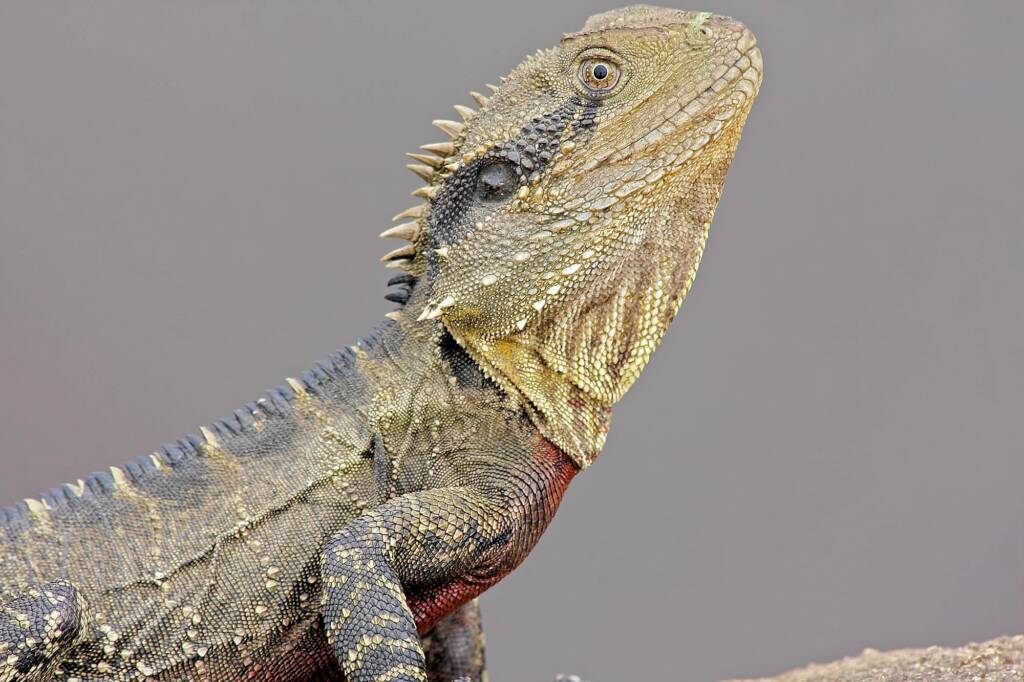The Southern Downs, Queensland region is home to a number of reptiles species.
Checkout some of our listed species:
- Bandy Bandy (Vermicella annulata)
- Bearded Dragon (Pogona barbata)
- Burton’s Legless Lizard (Lialis burtonis)
- Cunningham’s Skink (Egernia cunninghami)
- Eastern Water Dragon (Intellagama lesueurii lesueurii)
- Eastern Water Skink (Eulamprus quoyii)
- Tryon’s Gecko (Oedura tryoni)
- Red-bellied Black Snake (Pseudechis porphyriacus)
- Scientific classification
- Kingdom: Animalia
- Phylum: Chordata
- Subphylum: Vertebrata
- Informal: Gnathostomata
- Class: Reptilia
Check out some of the reptiles found in the region. Photographs by Marc Newman.
Bearded Dragon (Pogona barbata)
The Eastern Bearded Dragon (Pogona barbata), also known as Bearded Dragon, Common Bearded Dragon or Bearded Lizard, is usually found in wooded parts of Australia. One of a group of eight recognised species that are commonly referred to as bearded dragons. P. barbata resembles the Central Bearded Dragon (Pogona vitticeps).

- Scientific classification
- Kingdom: Animalia
- Phylum: Chordata
- Subphylum: Vertebrata
- Informal: Gnathostomata
- Class: Reptilia
- Subclass: Lepidosauria
- Order: Squamata
- Suborder: Lacertilia
- Family: Agamidae
- Genus: Pogona
- Species: Pogona barbata
Burton’s Legless Lizard (Lialis burtonis)
Burton’s Legless Lizard (Lialis burtonis) lacks forelegs and has only rudimentary hind legs. This species is native to Australia and Papua New Guinea. Found almost across Australia, with some exceptions including parts of southern Australia and Tasmania. The Burton’s Legless Lizard is found in a variety of habitats from deserts to the margins of rainforests, excluding the southern alpine region and extreme northern deserts. Usually found in low vegetation, grasses or leaf litter debris on the ground.

- Scientific classification
- Kingdom: Animalia
- Phylum: Chordata
- Subphylum: Vertebrata
- Informal: Gnathostomata
- Class: Reptilia
- Subclass: Lepidosauria
- Order: Squamata
- Suborder: Gekkota
- Family: Pygopodidae
- Genus: Lialis
- Species: Lialis burtonis
Cunningham’s Skink (Egernia cunninghami)
Cunningham’s Skink (Egernia cunninghami), also known as Cunningham’s Spiny-tailed Skink, is named in honour of the English botanist and explorer Allan Cunningham. Growing to about 40 cm in length (including tail), this skink has a distinctive keel on each scale, that gives it a slightly spiny appearance. Variable in colour, that can range from dark brown to black, with or without blotchy patches, speckles, or narrow bands.

- Scientific classification
- Kingdom: Animalia
- Phylum: Chordata
- Subphylum: Vertebrata
- Informal: Gnathostomata
- Class: Reptilia
- Subclass: Lepidosauria
- Order: Squamata
- Suborder: Lacertilia
- Family: Scincidae
- Genus: Egernia
- Species: Egernia cunninghami
Eastern Water Dragon (Intellagama lesueurii lesueurii)
The Eastern Water Dragon (Intellagama lesueurii lesueurii), a subspecies of the Australian Water Dragons, colour tends towards white, yellow and red on the throat and possesses a dark band behind its eye. They are light, sometimes greenish grey in overall colour with black bands running across their back, tail and legs. The water dragon can slowly change skin colour to aid its camouflage. The skin will shed during periods of growth.

- Scientific classification
- Kingdom: Animalia
- Phylum: Chordata
- Subphylum: Vertebrata
- Informal: Gnathostomata
- Class: Reptilia
- Subclass: Lepidosauria
- Order: Squamata
- Suborder: Lacertilia
- Family: Agamidae
- Genus: Intellagama
- Species: Intellagama lesueurii
- Subspecies: Intellagama lesueurii lesueurii
Eastern Water Skink (Eulamprus quoyii)
Commonly known as the Eastern Water Skink (Eulamprus quoyii), or Golden Water Skink, is a viviparous (bring forth live young that developed inside the body of the parent) species of diurnal (active during the day) skinks. Edemic to Australia and found mainly along the east coast of the country and is considered a common garden reptile. Usually identified by the twin, long yellow stripes that run along its body from the top of the eye, along with some other specific characteristics.

- Scientific classification
- Kingdom: Animalia
- Phylum: Chordata
- Subphylum: Vertebrata
- Informal: Gnathostomata
- Class: Reptilia
- Subclass: Lepidosauria
- Order: Squamata
- Suborder: Lacertilia
- Family: Scincidae
- Genus: Eulamprus
- Species: Eulamprus quoyii
Tryon’s Gecko (Oedura tryoni)
The Tryon’s Gecko (Oedura tryoni), also known as Tryon’s Velvet Gecko current known distribution is along south-eastern Queensland down through north-eastern New South Wales. The Tryon’s Gecko pictured was seen around the bee hotel in the photographer’s garden in Ballandean, Queensland.

- Scientific classification
- Kingdom: Animalia
- Phylum: Chordata
- Subphylum: Vertebrata
- Informal: Gnathostomata
- Class: Reptilia
- Subclass: Lepidosauria
- Order: Squamata
- Suborder: Gekkota
- Family: Diplodactylidae
- Genus: Oedura
- Species: Oedura tryoni
Red-bellied Black Snake (Pseudechis porphyriacus)
The Red-bellied Black Snake (Pseudechis porphyriacus) is one of eastern Australia’s most commonly encountered venomous snakes. Averaging around 1.25 metres in length, it has glossy black upperparts, with bright red or orange flanks, and a pink or dull red belly.

- Scientific classification
- Kingdom: Animalia
- Phylum: Chordata
- Subphylum: Vertebrata
- Informal: Gnathostomata
- Class: Reptilia
- Subclass: Lepidosauria
- Order: Squamata
- Suborder: Serpentes
- Family: Elapidae
- Subfamily: Hydrophiinae
- Genus: Pseudechis
- Species: Pseudechis porphyriacus
Bandy Bandy (Vermicella annulata)
Commonly known as Bandy-bandy (Vermicella annulata), also spelt Bandi Bandi, is a venomous snake with 48 or more contrasting black and white rings that fully encircle the body. They have small eyes and the tail is bluntly-tipped. Also know as the Hoop Snake, as when threatened, the snake raises loops of the body vertically off the ground.

- Scientific classification
- Kingdom: Animalia
- Phylum: Chordata
- Subphylum: Vertebrata
- Informal: Gnathostomata
- Class: Reptilia
- Subclass: Lepidosauria
- Order: Squamata
- Suborder: Serpentes
- Family: Elapidae
- Subfamily: Hydrophiinae
- Genus: Vermicella
- Species: Vermicella annulata
Footnote & References
- Reptiles of Southern Downs local government area, WetlandInfo, Queensland Government, https://wetlandinfo.des.qld.gov.au/wetlands/facts-maps/wildlife/?AreaID=lga-southern-downs&Kingdom=animals&Class=reptiles
- Atlas of Living Australia, https://www.ala.org.au/
Southern Downs QLDSouthern Downs Fauna Southern Downs Bees Southern Downs Birds Southern Downs Crustacean Southern Downs Frogs Southern Downs Insects Southern Downs Marsupials Southern Downs Reptiles Southern Downs Spiders
QueenslandGold Coast Region Lamington National Park Southern Downs QLD
